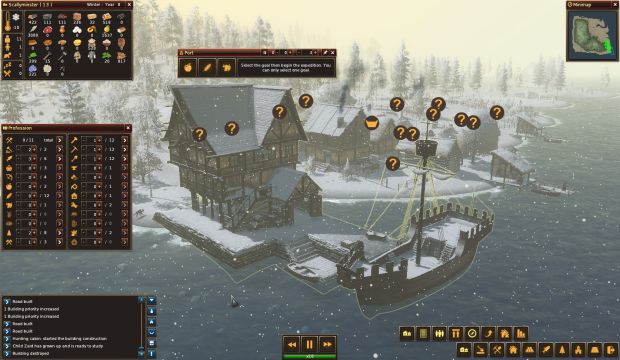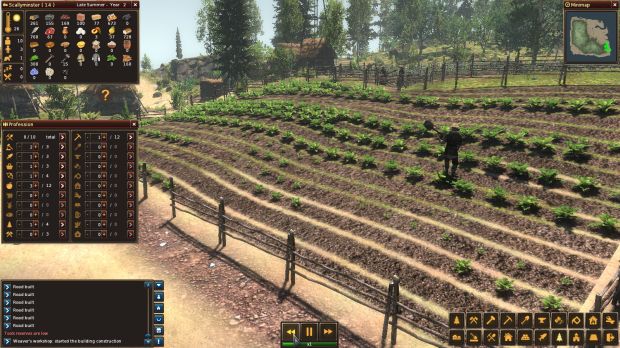Premature Evaluation – Life Is Feudal: Forest Village
Anarcho-syndicalist forest commune
Every Moday we send Brendan to plough the fields of early access and see if anything nutritious grows. This week he mismanages a settlement of brow-beaten farm workers in Forest Village [official site], a placid spin-off from Life Is Feudal’s medieval sandbox.
The village of Scallyminster lies in ruins. I’d like to think I did everything in my power to help the last citizens of this dying village, but that would be a lie. They followed my orders, like good computerised serfs, right to the bitter end. The village is empty of life now, except for the bears, who have always been very pleasant. I don’t think the game will let them feast off the frozen corpses of the last six villagers. Which is a pity, because the citizens of Scallyminster murdered plenty of bears in their time, before the fall, that is. Before the 13th Year.
But we’re getting ahead of ourselves. This is Forest Village, or to give it its full title, Life Is Feudal: Forest Village. It’s a management sim counter-argument to the medieval survival game of the same series. It also bears a close resemblance to the farming and village management of Banished, and rests a lot of its appeal on the survivalism of its cousin. You need food to stay alive, for instance, lots of food. But you also need firewood for warmth and a roof over your head. And when I say “your head” I really mean “the heads of your idiotic labourers”.
You begin with a few shacks and a handful of people. By plonking down fishing piers and farms you can begin to make a living for your underlings. But you also have to entrust each of these production facilities with a worker or two (or three or four). Farms especially will need more people the bigger they get. My first potato farm turned out to be far too big and I had to assign four workers to make sure everything got harvested in time for the winter. Because yes, seasons matter.
This is one of the game’s strengths. Not only are you constantly checking the number of vegetables, fish, apples, and meat stocked in your barns and warehouses, you also have to keep an eye on the time of year and the temperature. When autumn comes, the first frost will instantly kill any crops that remain unpicked. You can slave away all summer but if you don’t get harvesting at the right time, half of your crop will go to waste. You can click a button to reap the fields immediately at any time, but it’s smarter to build a field with the right dimensions to fit your population, and in this way the little villagers will pluck the spuds and dig up the apples as soon as the field is full, automating the process.
There’s also an unspoken tech tree of sorts. You need a lumberjack’s yard for firewood but you also need a kiln to turn that firewood into charcoal. Then you need charcoal and ore to make metal ingots and metal ingots to make strong, iron tools. The same logic applies to pies, which require a bakery and lots of the types of things that go into pies, like, I don't know, hooves. You can make meat pies and fruit pies and veggie pies and then when you have enough of them you can put them all in a ship and go on an expedition to discover some new crops, like pumpkin or corn, or new animals, like Things That Aren’t Bears.
The bears love your village, you see. They aren’t yet programmed with violent behaviour (that is, if they will ever be programmed this way) so along with wolves, wild boars, foxes and stags, they kind of just mill around, living in perfect harmony with your dark age peons, until you set up a hunting lodge and assign a worker to put them all into pies. The animals don’t seem to mind this and willingly give up their bodies to feed your people. They’re the most understanding bears I have ever met.
After a while your people start to have babies – this is how you bring more workers to the fields and workshops of the town, slowly expanding the village with each snowfall. Most of the game is played by simply clicking plus and minus symbols next to each facility, making sure people aren’t idling and that everyone is doing the right job at the right time. If the blacksmith is sleeping, you had best throw him down a mine or into a windmill.
You’re always understocked in some regard, so this shuffling of human resources is often what determines who lives and who dies. Sometimes people die in farming accidents, or crushed in a mine. One of my builders died in childbirth once, along with the infant. But more often they starve to death, or freeze, because you forgot to set a worker on firewood duty or didn’t send the farming squad to the cabbage patch this year. You damned fool.
The village of Scallyminster had all these problems and more. When my population didn’t increase for ages I realised that the houses needed to be upgraded to increase a chance of pregnancy. I assigned all the shacks in town to be renovated but didn’t consider that the peasants would have nowhere to stay while the work was being done. One of the women did get pregnant, but her child - the first baby to be born in over four years - subsequently died of exposure when her mother had no cot to put her in. My bad.
I built a chicken coop when the supershacks were finished and the woman in charge of the hens managed to feed a single oat to a lone chicken before it was promptly devoured by a fox. That same woman spent the next year pretending to work and feeding zero chickens. If there is a way to regenerate hens, short of rebuilding the coop everytime the “starter hen” is eaten, then I do not know about it. I kept two eggs for three years and they did not hatch.
There are other early access oddities. The terraforming options are daft and hyper-fiddly. You can create farms over hills and slopes (and they look great like this) but you can only build large structures on flat ground. So you have to use a terraforming tool to push it down in big grids. As a result the land goes from looking gorgeous and naturalistic to being a bizarre landscape of sharp polygons and stretched textures. I’m sure this will be polished in the intervening years but given the lack of flat land by default, it currently becomes necessary to fill your village with wonky grass spikes and surreal quarries, making roads (which allow villagers to travel faster) sometimes impossible to place.
Nightfall is also a huge pain. As soon as it becomes dark all your dumb villeins go to their pits. That’s fine, they need their rest if they’re to die in a tragic windmill accident tomorrow. But what’s not fine is the descent of pitch black in the game, a darkness so profound that you can’t reliably place any constructions, roads, wells or terraforming plans. And since the game also has a somewhat glacial pace, you tend to spend most of your time in the speedy ‘fast forward’ mode – meaning night comes often enough for this recurrent blindness to become a huge annoyance.
There are some things that make up for this. For example, it includes the neat trick of being able to possess any worker at any time and go wandering around inspecting the wheat fields or looking out to sea, or chopping wood or picking plants. It’s a serene sideshow to all the overhead bossing around, being able to suddenly inhabit these chattels and go for a quiet walk through the fields or up to the forest on the hill or down to the beach. There’s an odd magic to it. Then you remember that Carlos should be harvesting the hay and you hit escape and start telling everyone to brace for the oncoming tornado.
That said, there does feel to be a very limited lifespan in it so far. It's a hugely sedentary game too, moving so slowly that I often had it running in ‘fast forward’ mode in a window while I read the Sunday internet. The goal seems to be to build as big a town as possible and to go on multiple sailing expeditions to get all the new crops and animals, so as to make your people the best bondsmen possible. Someday, you reason, you will be able to leave things ticking over and the men and women of your poxy village will be able to take care of themselves, like some sort of anarcho-syndicalist commune. I know this is the dream, because I attempted it one fateful year in the Scallyminster’s short history - the 13th Year.
I set each man and woman to their work and left in the fall. With potato-pickers in the fields and carpenters in the workshop and bakers at the oven and millers making flour, everything looked A-OK. I left my computer and made a breakfast composed of delicious ingredients that the bumpkins of Scallyminster would never know. When I returned, four years later, only six villagers were still alive – two fishermen, a gardener, the oat harvester, a carpenter and – inexplicably – the school teacher, who now spent every day looking at empty chairs in the classroom, since all the children had long ago died of starvation. The same fate had befallen the others, except the herbalist and the hunter, who both managed to die of old age (well done). Of the six villagers who survived the dark years, zero were women. With six men between the ages of 70 and 20 years old, there was no way to continue the village. The people of Scallyminster were effectively extinct.
I set the six men to task, dismantling everything. They began, ill-advisedly, with their own houses. Homeless and overworked in the dead of winter, they each succumbed to hypothermia while trying to remove bricks and planks from the tavern roof. When the last of the men passed from this world, I expected a prompt, some kind of ‘game over’ screen. But the simulation just carried on. The night came and more snow settled. The sun rose on the abandoned village, and new inhabitants began to prowl the snowy streets. The bears had returned to Scallyminster. Never again would they be baked into a pie.
Life Is Feudal: Forest Village is available on Steam for £18.99/$24.99. These impressions are based on build 1316845














